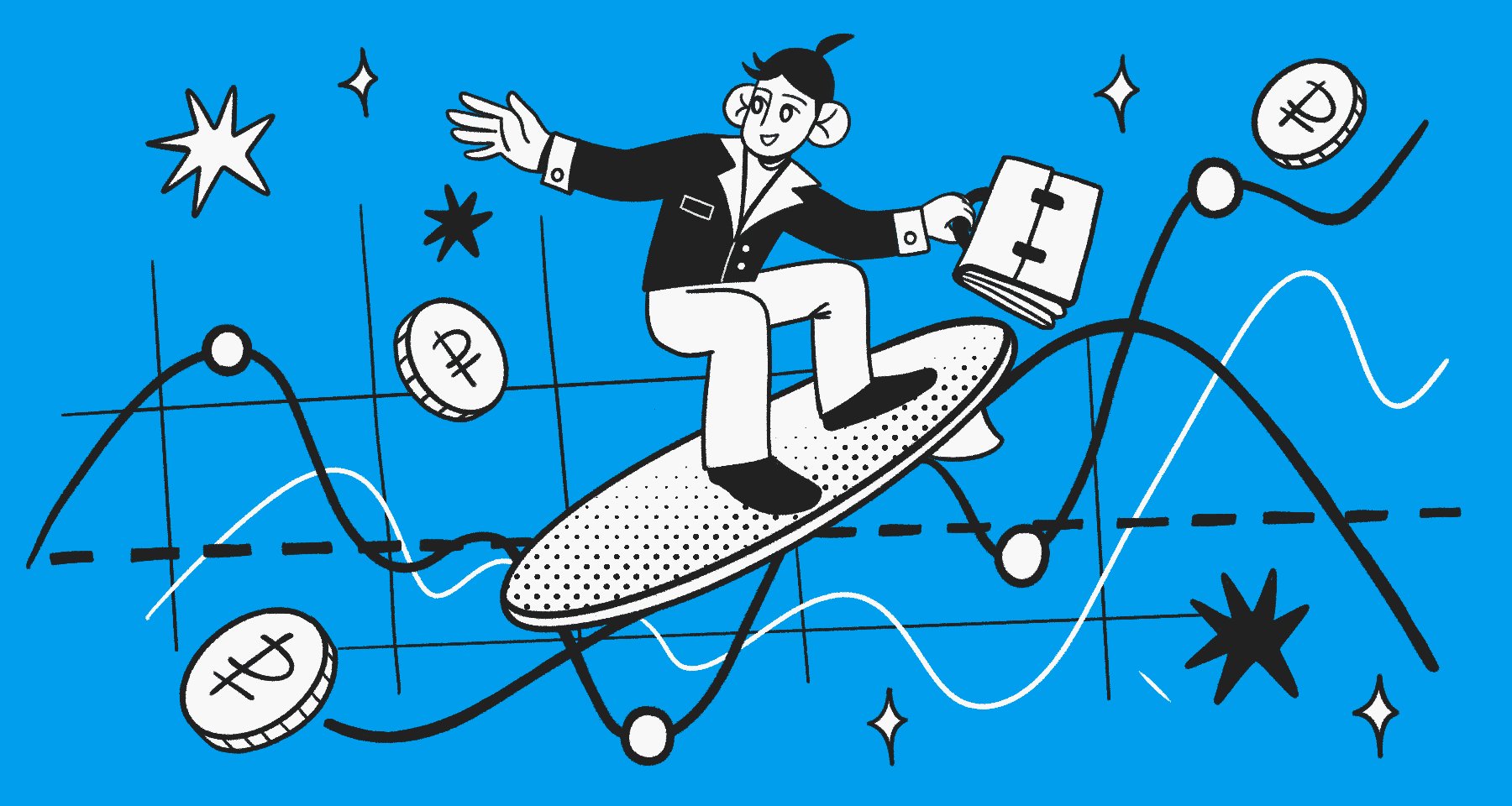The content of the article
Show
Hide
According to modern economic theory, the market economy is subject to repeated fluctuations – economic cycles. At the stage of recovery, there is an acceleration of production and an increase in prices, at the stage of recession – on the contrary.
Each cycle includes several phases – a period of economic growth and recession. Cycles can relate to the economy of a single country or the global economy as a whole.
As a rule, there are four main types of economic cycles that have different durations: Kitchin and Juglar cycles, Kuznets rhythms and long Kondratiev waves.
We tell you what phases economic cycles have, when the next cycle will begin and whether it can lead to an increase in oil prices up to 300 per barrel, and gold up to 5 thousand dollars per ounce.
How business cycles work: four phases
Every business cycle has four phases: boom, peak, bust and bottom.
A boom is a period of growth in economic activity from the lowest point of the cycle to the highest. It is characterized by an increase in investment, output and employment of the population. Peak is the highest point of economic activity within the cycle. Choose a broker for investment Recession (recession) – a period of decline in economic activity from the highest point of the cycle to the lowest. It is characterized by a decrease in investment, output and employment. A particularly long and deep recession is called a depression. A bottom is the lowest point in an economic downturn.
Cycles in modern economic science are considered a phenomenon of a market economy, which is absent in a planned economy. According to the US National Bureau of Economic Research, there were 33 cycles of varying length and depth in the American economy between 1854 and 2009.
What are economic cycles
There are the following cycles:
short-term Kitchin cycles (named after the English economist Joseph Kitchin) – a characteristic period of 2–3 years; medium-term Juglar cycles (in honor of the French economist Clement Juglar), 7–11 years; Kuznets cycles (rhythms) (in honor of the American economist Simon Kuznets) , 15–20 years old; long waves of Kondratiev (in honor of the Soviet economist Nikolai Kondratiev), 48–55 years old.
At the same time, most modern economists are inclined to believe that the cycles are of a random nature, arising as a result of external influences (shocks), therefore, they are difficult to predict accurately.
The duration and amplitude of oscillations of cycles can vary significantly. The duration of the cycle depends on the nature of the shock and on the response of states and governments to it.
What is the current economic cycle
The global economy is now slowing down, experts interviewed by Banki.ru say. Many economists have been warning about the threat of a global recession since the beginning of 2022.
Valery Emelyanov, an expert on the stock market at BCS World of Investments, believes that, if we consider the shortest cycles (Kitchin), the world economy is on its way to the bottom of the recession – the bottom of the cycle. “But is this so, it will be clear only after the fact. It is possible that the bottom was passed in the first half of 2023,” he says.
How short positions work and how to short the stock market
Juglar waves, according to Yemelyanov, are applicable to investment activity, including in commodity markets. Judging by the balance of supply and demand, as well as the dynamics of prices, the world economy is halfway to the bottom, he says. The analyst explains that raw materials have been getting cheaper for a year already, and this trend may continue for at least another year.
The Kondratiev cycles, according to the expert, are rarely used in analysis and are more interesting from a historical point of view. Yemelyanov draws attention to the fact that, on a 30-year cycle, the geopolitical crisis associated with the events in Ukraine is as insignificant an event as the war in Iraq in 2003, which affected oil prices, but not for long.
What’s happening to commodity prices
At the end of June, Bloomberg wrotethat a new long-term economic cycle, namely the Kondratieff cycle, will begin as early as the beginning of July this year. This will mean a period of rising world prices for raw materials and food products. The article noted that after peaking in the late 2000s, the commodity price index began to decline. Now it is returning to the mark from which the previous growth began.
At the same time, the dynamics of world commodity prices does not yet indicate the end of the old cycle in 2023 and the beginning of a new one. To illustrate, consider four commodities: oil, gold, copper, and wheat.
The historical maximum price of oil was recorded in 2008, when a barrel of Brent oil cost more than $140. Then the price dropped sharply. Despite periods of recovery, the price has not approached a peak level for more than a decade, only last year it jumped to a level of more than $130 per barrel.
The price of gold began to fall later than the price of oil. It peaked in 2011 at around $1,900 per troy ounce. New growth began already in 2018, and in 2020 a new price record was set – more than $2,000 per ounce. In 2022-2023, the price of gold was approaching this peak.
The price of copper, like the price of gold, began to decline in 2011 from a high of $4.5 per pound. But since 2020, the price has risen steadily and hit a new peak of $4.9 per pound in 2022.
The price of wheat, like the price of oil, has been declining for a long time after the high of 2008 (about $13 per bushel). Since 2018, the cost of the commodity has shifted to growth, and in March 2022, there was a surge in prices to a new high of more than $14 per bushel.
Yemelyanov believes that the jump in commodity prices in 2022 was not the beginning of a new cycle, but was a continuation of the old one. According to him, prices for raw materials periodically jump up, but in general, a decrease in quotations has been observed over the past 15 years.
Should we wait for the start of a new economic cycle in 2023?
It is not worth counting on a quick start of a new Kondratiev cycle and an increase in raw material prices, says Denis Popov, chief analyst at PSB. He explains that the start of a long-term cycle may take several years, and throughout this period, high volatility or a noticeable decrease in prices in commodity markets cannot be ruled out.
Forecasting long-term economic cycles is a rather difficult task, and besides, they manifest themselves on a scale of decades, adds Olga Belenkaya, head of the macroeconomic analysis department of FG Finam. In her opinion, now many factors indicate a likely long-term stagflation in the global economy (increased inflation and weak economic growth).
“This is due to the budget deficits of many large economies, geopolitical tensions, partial deglobalization and economic confrontations, the “green transition”, and the long-term underinvestment in the oil industry,” the expert explains. These factors, according to her, lead to a shortage of resources, technologies, contribute to rising costs, which means that prices for raw materials can grow in the long term.
Get advice on promotions
On the other hand, Belenkaya continues, central banks are trying to control high inflation by raising interest rates, which increases the risks of a recession and a financial crisis. This may temporarily “pressure” commodity prices, she notes. “But the ability to defeat inflation only by monetary methods is limited and, perhaps, central banks will have to put up with increased inflation for a while,” the expert predicts.
Typically, commodity prices rise in the late cycle of economic growth, says Yemelyanov. According to him, at this stage, investors are buying up any risky assets, including futures for oil and metals, because all other assets are already too expensive. “For some spectacular and lasting rise in the prices of fuels and basic materials, there must first be an impressive economic boom,” he states. The expert adds that now the world is experiencing a high demand for shares of Western companies, primarily technology. Such a phenomenon happens before the start of GDP growth, but not at a late stage of the cycle, Yemelyanov notes.
Popov draws attention to the fact that in June, Russian President Vladimir Putin “gave a signal” about the transition to building a “supply-side economy.” Its essence lies in the fact that economic policy should not only respond to the dynamics and vector of market conditions, but also be aimed at the formation and satisfaction of demand, he explains. “In the coming years, the development of the Russian economy is likely to occur mainly due to internal drivers,” the expert believes.
What will happen to the dollar
In the fall of 2022, the dollar index updated its maximum in 20 years, reminds Belenkaya. The US Federal Reserve was more resolute than other central banks in raising interest rates, and this was reflected in the outpacing growth in the yields of US government bonds, in the expansion of the interest rate differential for the dollar and other currencies. But as other central banks also began to actively tighten monetary policy, the dollar has lost some of its previous strength, she points out.
Here you can find out the current exchange rates in banks and exchangers.
Popov considers the prospects for the ruble exchange rate in the coming years “ambiguous.” In his opinion, even if a new commodity supercycle begins, the ruble will be stable and will be able to show only a moderate strengthening. The expert explains that in most countries – Russia’s trading partners, the inflation target is lower than in Russia (4%). This means that, other things being equal, the relative depreciation of the Russian national currency will occur faster. The Central Bank of the Russian Federation plans to revise the inflation target, Popov says, but it will take at least two to three years to reduce inflation, so the medium-term forecast of the PSB assumes a moderate weakening of the ruble.
Raw material prices are inversely related to the value of the dollar (against the euro, pound sterling or yen), Yemelyanov adds. But the dollar grows against the ruble in any cycle and political system, he concludes.
With the help of the Banki.ru service, you can choose a deposit or a savings account, study the topic of investments more, choose a broker, and also find out the situation on the metal, currency and real estate markets.
More on the topic:
Buy, hold or sell: how an investor should behave in the stock market in summer #}
Rate: from 5.5%
Payment: 9 059 ₽
Pick up a loan
#}
2023-07-06 19:31:00
#Economic #cycles #stage #economy #oil


